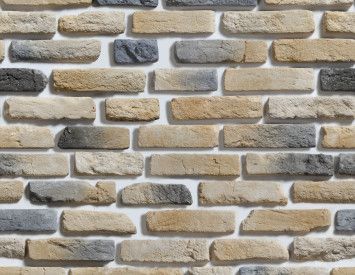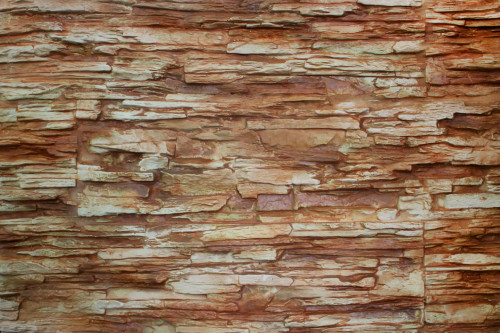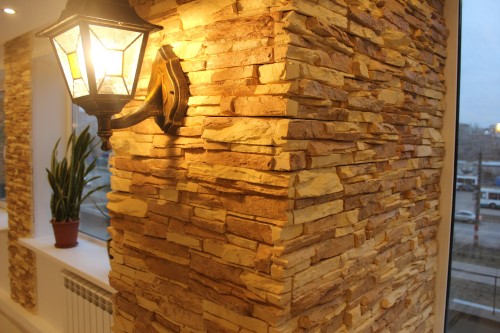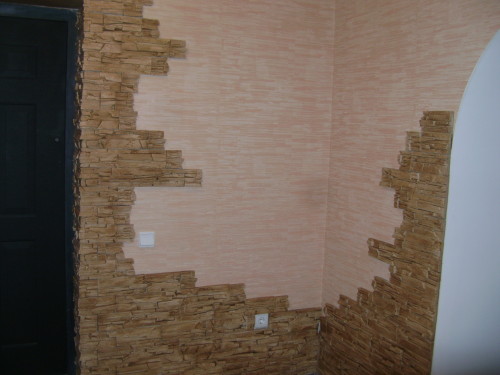A stone is one of the best finishing materials, which today is used quite often. Often the stone is used to decorate facades, fountains, porch, as well as other objects located outside the internal space of the dwelling. The thing is that this natural material is in the best way to combine with other objects. Moreover, over time, the stone begins to grow in moss. This creates a kind of atmosphere, which is difficult to implement by many specialized materials.
Content
However, today we will talk about decorative stone, which is often used within the dwelling. Given that this material is artificial, you can get the most diverse variations of the product. Thus, we can transform the living room, make it colder, or vice versa - warm and attractive for residents and guests of the apartment. In the home interior, the stone can be used almost everywhere, especially if this product has a neutral appearance.
In this article, we will talk about the use of decorative stone for finishing the kitchen walls. The trend on such design solutions appeared relatively recently, but already managed to conquer the hearts of many owners of apartments. The thing is that with the proper approach, we get a really unique design in which the stone emphasizes the solidity and insanity of the kitchen space.
Features of the use of decorative stone for wall decoration
Many people mistakenly believe that on the basis of decorative stone there are only a couple of wall options. However, this is completely wrong. You can find hundreds of sites on which thousands of wall decoration options are presented, and this is without the slightest exaggeration. The thing is that on sale you can find a huge amount of diverse decorative stone. Accordingly, we have the opportunity to create an original design using one or another form of stone, its color, as well as a unique texture.
Also, many people think that when finishing it is necessary to cover the entire wall with a stone. It is obvious that this is a serious misconception, since it is more advisable to install stone only in individual parts of the wall. This will emphasize the subtlety of the created design solution. However, there may be exceptions. It all depends on the selected design or on the scale of work.
As for living rooms, decorative stone often emphasizes fireplaces, aquariums, doorways, as well as places where indoor plants are located. In approximately the same way, you can decorate any other object located in the room. The main thing is to do it in moderation, so as not to spoil the room.
There are some restrictions on the use of decorative stone, and first of all, this applies to kitchens. The bottom line is that narrow rooms are very poorly combined with large decorative stones. In such cases, it is better to limit yourself to the usual finishing materials. A large stone in a modest room can significantly reduce the space (visually), after which the room will look even more compact, and, therefore, uncomfortable and limited.
Advantages and disadvantages of decorative stone
Positive sides:
- Original appearance. It is possible to talk with the manufacturer about the creation of a decorative stone based on their own ideas. This is a great solution, since in the end we can get a unique kitchen style. In any case, each company has huge catals, where many different options for decorative stone are presented.
- Impact resistance. Even a decorative stone, unlike many other finishing materials, practically does not respond to blows. There is no scratches or dents left on the material. Even if the stone turns out to be damaged, this is not the appearance of the room in any way. It is likely that some people will perceive damage as a successful design move. Surely this is the main advantage of the stone - it looks great in any condition.
- Environmental friendliness. Obviously, the stone is a safe material that can be used in completely different rooms. This cannot but rejoice, since many finishing materials have many drawbacks in this matter.
Negative aspects:
- The service life. In this case, many compare a decorative stone with natural material. Indeed, artificial stone will last much less than the present. However, do not think that the life is too limited. It can be decades, while natural stone has no restrictions in terms of the period of use. But do not forget that natural stone is not so cheap.
The remaining disadvantages of decorative stone are not so serious. However, it must be said that in many respects the artificial product is inferior to natural stone, and this must be remembered.
Preliminary surface treatment
Before starting laying decorative stone, it should be borne in mind that at first we need to qualitatively process the surface of the wall. At this stage, the process is no different from what we have during wall cladding with ceramic tiles. Accordingly, first you need to level the surface of the wall.
Since we carry out repairs in the kitchen, we need to keep in mind that not the entire wall should be given alignment, but only those areas that will be finished with decorative stone.
At the same time, many builders allow some surface curvature (small), which positively affects the final result of the work. In addition, you need to pay attention to the strength and reliability of the wall, since under the weight of the stone, the created finish can simply collapse.
First you need to surstile walls. At the same time, it is recommended to use reinforcement in the form of a construction grid. This solution will significantly strengthen the wall. Accordingly, one can not be afraid about the weight of stones, there should be no special restrictions in this regard.
You can also sheathe the wall with drywall, but the thickness of the material should not exceed 12.5 mm. Fasten the sheets of material should be immediately in three places, this will significantly increase reliability.
As for the consolidation of the decorative stone itself, most often, tile glue is used, which without problems holds a considerable weight of the material. You can also look at silicone glue, which has recently been involved in construction more and more often. Liquid nails are particularly effective. Many people know that this glue almost tightly fixes certain building elements, so there can be no restrictions in the plan of use of liquid nails.
In many cases, the use of a classic cement mortar can be observed. This is also a good option, but only if the stones used in the process are relatively small. Often, various plasticizers are added to the mixture, as well as PVA glue (construction). This solution significantly increases the strength of cement. If everything is done correctly, then the solution is uniform and thick enough.
Other preliminary actions:
- It is necessary to create a small sketch, with the help of which we will approximately navigate the existing volumes of work. Obviously, it is better to take care of this in advance, since the amount of the necessary stone, as well as building materials, depends on it. Also at this stage, you need to decide which type will have a finish. In some cases, the stones are located in the end, and sometimes a small seam is created. Much depends on this, for example, the number of necessary stones. Speaking frankly, the second option looks a little nicer in appearance. Moreover, this is a really reliable option for attaching stone on the wall.
- Also, the sketch will not hurt to transfer to the wall itself. It should be borne in mind that the most important thing here is the accuracy and correctness of all components of the finish, otherwise unexpected problems may arise in the future process.
- It is also necessary to limit the places where the wall decoration ends. For example, there should be no decorative stone in the area of \u200b\u200bthe skirting board, so you need to create a small border to prevent a mistake. Often, special profiles are used for this, which are located around the entire working space. In this situation, it certainly cannot be mistaken. The profiles are attached directly to the wall, and after the end of the work, they can be easily removed.
Next, we immediately proceed in the wall decoration.
Wall decoration with decorative stone
In this case, the most minimum of the necessary tools and materials will be required. First of all, we are talking about a spatel with which we will apply a cement mortar to an artificial product.
In the event that if the stone is laid, it is necessary to tightly press the building elements to each other, while you can slightly turn the stone so that it is tightly located in a specific place.
If it is decided to create a small seam between decorative stones, it is best to use plastic crosses for this. Surely many used these during masonry of facing tiles. Everything is approximately the same, but the sizes of the crosses should be larger, otherwise it will not turn out very harmoniously. Of course, it should be controlled so that the distance between the stones is the same, otherwise it will negatively affect the overall composition.
The process of decoration of the wall with a decorative stone begins in the very first row, which should be located below. Accordingly, first you need to apply a cement solution to the width of the row.
The intricacies of the laying process of decorative stone:
- It must be borne in mind that decorative stone often resembles a brick, so laying should be done by approximately the same principle. Accordingly, the rows are located with a slight displacement, which looks very good within the dwelling.
- If the decorative stone resembles natural material, you should also finish the wall with a slight displacement. It should be borne in mind that the dimensions of the elements of a row should be approximately the same. Only in this case you can be sure of the qualitative result.
- It is often required to cut a stone. Here you need to use the most ordinary grinder. In this case, it is necessary to ensure that the incision of the material does not affect the general decorative component of the created finish. It is advisable not to resort to such manipulations too often, since the appearance of the finish can change significantly.
The stone is placed in rows, but it should be borne in mind that the cooked cement mortar is enough for approximately 15-20 minutes, and then it becomes unsuitable for use. Therefore, cement should be kneaded in small volumes.
Especially seriously should be treated with a decorative stone with a large weight. In this case, the ranks can slightly shift under the influence of large weight of the material, so the process must not be carried out too quickly. It is best to lay two rows and stop. Later, when the cement grasps, you can continue the process.
After laying all rows of decorative stone occurred, it is necessary to wait a while before the cement solution dries. It often takes 2-3 days. Next, you can safely remove the underlying profile, which held the first row, as well as the crosses necessary for the creation of the seams.
Accordingly, the last stage of work is a grout of the seams. To do this, it is best to use a grout of about the same color as a stone. The application of the material occurs using a sponge (the simplest and most reliable option). Of course, no gaps or gaps between the stones cannot be allowed. It also does not hurt to apply a primer to a decorative stone, since this material is not protected from external negative influences.













